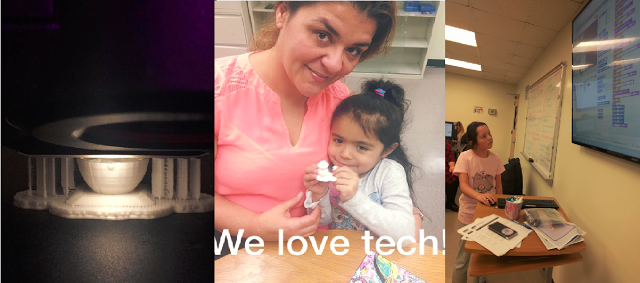3 Gifts of Tech Learning "with" Educators & Families

What benefits might we see if time was set aside for teachers to learn "with" their students/children and parents? How could that even happen easily? I mean when do teachers, parents, and young people even want to learn the same thing. How could there be time for all these audiences to join together? #NYCSchoolsTech Leader, Lori Stahl-VonBrackle brought this idea to life over the winter break at her learning center in Manhattan.
Here's what she did it and why it worked.

Photo 1) Designing a snowman for the 3D printer.
Photo 2) The product with mom/NYC Schools teacher Cidalia & her child/ NYC Schools preschool student
Photo 3) Student/child explains her Scratch project
Lori offered high-interest, relevant classes that educators, parents, and young people are hungry for. She offered a morning of making with 3D printing with a MakerBot and an afternoon of Scratch programing to learn how to create interactive games, stories, and animations. Then she let the magic begin when these audiences have the opportunity to learn together. Here is what happened:
1) Learning Accessibility
Teachers: Teachers who would have had difficulty taking advantage of such opportunities because of child-care, were suddenly freed to learn with their child.
Families: When students are on break, families have child care responsibilities. Spending the day learning and understanding something children love is a terrific way to not only learn together, but also understand what the children in your life are learning at school.
Tools and ideas to transform education. Sign up below.
2) Growing Confidence
When parents and/or teachers have the ability to learn one-on-one with children they build the knowledge necessary to feel comfortable supporting children at home and in the classroom. Having that one child to really sit with and focus on in a learning setting is a rare opportunity. When a child and adult learn side-by-side they can see what the children learn quickly and where it is they can use support. The same can be said for adults! Of course you can not gage a diverse set of learners based on one child, but you do gain unique insight that help gain confidence when teaching a class or supporting children with homework in a new area.
3) Building Community
When children, families, and teachers unite to come together to learn, relationships are developed and a culture of learning blossoms. It is a powerful experience for adults and youth to learn together. Each of their talents are able to shine and the opportunities to safely and support one another's challenges is available. A community that learns together gets smarter and stronger.
So what do you think? Can (or are) you doing something like this where you work? If so, what is working? If not, might you try it? What are you wondering? What are you excited about?
Lisa Nielsen writes for and speaks to audiences across the globe about learning innovatively and is frequently covered by local and national media for her views on “Passion (not data) Driven Learning,” "Thinking Outside the Ban" to harness the power of technology for learning, and using the power of social media to provide a voice to educators and students. Ms. Nielsen has worked for more than a decade in various capacities to support learning in real and innovative ways that will prepare students for success. In addition to her award-winning blog, The Innovative Educator, Ms. Nielsen’s writing is featured in places such as Huffington Post, Tech & Learning, ISTE Connects, ASCD Wholechild, MindShift, Leading & Learning, The Unplugged Mom, and is the author the book Teaching Generation Text.
Disclaimer: The information shared here is strictly that of the author and does not reflect the opinions or endorsement of her employer.
Lisa Nielsen (@InnovativeEdu) has worked as a public-school educator and administrator since 1997. She is a prolific writer best known for her award-winning blog, The Innovative Educator. Nielsen is the author of several books and her writing has been featured in media outlets such as The New York Times, The Wall Street Journal, and Tech & Learning.
Disclaimer: The information shared here is strictly that of the author and does not reflect the opinions or endorsement of her employer.
